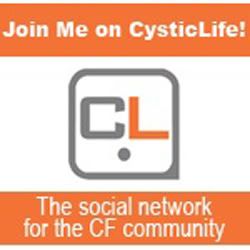I had a question thrown out to me yesterday on Facebook and I thought I'd share my answer here as well.
What if one parent has CF and the other parent is a carrier or isn't even a carrier, are your chances for having a CF child still the same? I'm so confused about this.
So, if two people with with TWO bad genes (both with CF) make a baby, the baby would virtually have a 100% chance of having CF since neither parent is able to pass down a "good gene".
If a CFer (TWO bad genes) makes a baby with a carrier (ONE bad gene and ONE good gene) the baby would have a 50% of getting TWO bad genes (the baby would have CF) and a 50% of getting ONE bad gene and ONE good gene (the baby would be a carrier)
If a CFer (TWO bad genes) makes a baby with a person who doesn't have CF and is not a carrier (TWO good genes) the baby would virtually have a 100% of getting ONE bad gene and ONE good gene therefore making the baby a carrier (ONE bad gene and ONE good gene).
If a carrier (ONE bad gene and ONE good gene) makes a baby with another carrier (ONE bad gene and ONE good gene) the baby would have a 25% chance of getting TWO bad genes (the baby would have CF) a 50% chance of getting ONE bad gene and ONE good gene (the baby would be a carrier) and a 25% of getting TWO good genes (the baby would not have CF and it would not be a carrier).
If two people who do not have CF and are not carriers make a baby, meaning they both have TWO good genes, then the baby would have a 0% chance of having CF.
If a carrier (ONE bad gene and ONE good gene) makes a baby with another carrier (ONE bad gene and ONE good gene) the baby would have a 25% chance of getting TWO bad genes (the baby would have CF) a 50% chance of getting ONE bad gene and ONE good gene (the baby would be a carrier) and a 25% of getting TWO good genes (the baby would not have CF and it would not be a carrier).
If two people who do not have CF and are not carriers make a baby, meaning they both have TWO good genes, then the baby would have a 0% chance of having CF.
Now this is obviously a very stripped down explanation but hopefully a simple enough one that is very easy to understand!










